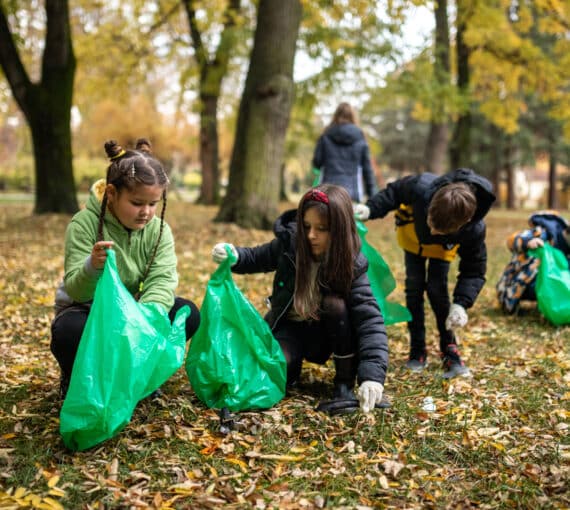
Participants from the UBC Climate Hub’s youth storytelling workshops join climate strikes in Vancouver. (Photo: Avery Holliday)
Climate change, a defining issue of our time, demands immediate, collective action. College and university campuses are often filled with passionate students willing and wanting to make a difference.
Whether your classes are in person or virtual, at home or on campus, you can spark change, live your values and build community by joining (or starting) a student-led climate-focused club at your post-secondary school.
How do campus clubs work?
Unlike grade school and workplace green teams, post-secondary student-led groups operate in more complex environments. Campus clubs have varying degrees of involvement from faculty, administration and/or external stakeholders. The groups are often autonomous. Students lead and drive the agenda.
The impact of student-led groups
Campus student-led groups have made significant contributions to environmental and social rights movements.
1964: University of California, Berkeley Free Speech Movement
One of the most well-known student-led movements in history began as a fight for students’ free speech rights and political activism on campus. It became a powerful voice in the broader civil rights and anti-Vietnam War movements. It inspired nationwide student protests and played a pivotal role in advancing U.S. free speech rights, establishing campuses as centres for political and social change.
2010s to present: #DivestCanada movement
Inspired by the global fossil fuel divestment movement, students in Canada have organized campus-based campaigns to pressure their universities and colleges to divest from fossil fuel companies. The #DivestCanada movement gained momentum in the 2010s with students from the University of Toronto, McGill and University of British Columbia leading. These campaigns have led to successes, with 12 post-secondary institutions in Canada committing to divestment.
2012 to present: Idle No More
Indigenous youth, students and allies throughout Canada have been advocating for Indigenous sovereignty and environmental protection. Many Indigenous and allied student groups on Canadian campuses played a key role in organizing protests, teach-ins and awareness campaigns. Idle No More has grown into a nationwide movement challenging harmful government policy, resource extraction projects and environmental degradation.

Case study: UBC Climate Hub
The youth-led initiative empowers people to take bold action on climate change though programs and initiatives that foster hope, joy and community.
Benefits of a student-led climate club
No matter what post-secondary institutions you attend, there are many benefits to joining a student-led climate club.
1. Turn climate anxiety into climate action
The climate crisis dominates headlines and scientific reports grow more alarming. No wonder many students feel overwhelming dread about the future. This emotional response is often referred to as “eco-grief” or “climate anxiety.” It stems from the growing awareness that the planet is facing existential threats due to human-caused environmental damage. The weight of inheriting a heating planet can feel paralyzing, especially for young people.
A 2023 study surveyed more than 1,000 young people throughout Canada about their climate concerns. Fifty-six per cent reported “feeling afraid, sad, anxious and powerless.” Seventy-eight per cent said climate change impacts their mental health.
Student-led campus climate clubs can be powerful antidotes to this despair. Through collective action and peer support, these groups help transform eco-grief into meaningful, solutions-focused activism.

Transform your climate concern into climate action
The world is close to a tipping point that would lead to climate chaos. But changing course is still possible. Choices we make today will determine the severity of future climate change impacts.
2. Take part in intersectional climate justice
Environmental issues don’t affect everyone equally. An intersectional approach to climate change acknowledges that various systems of oppression — power dynamics, racism, colonialism, sexism — compound climate impacts on certain communities.
Intersectionality is a way of examining issues to understand how characteristics such as race, place, age, gender, and geography intersect with each other and interact with power structures to create and reinforce power, privilege, disadvantage and discrimination.
Cam Humphrey, 2021 environmental justice fellow at the Yale School of the Environment
Campus climate clubs are in an excellent position to promote an intersectional approach. They often include diverse students from different academic focuses, backgrounds and lived experience. This creates dynamic conditions for collaboration and innovation.
The fight for climate justice requires more than individual actions. It needs systemic changes that can only happen through collective, intersectional advocacy. By joining a student-led climate group, you’ll become a part of a larger community dedicated to challenging the root causes of the crisis.

Environmental racism: What is it and what can we do about it?
Environmental racism occurs in Canada and around the world. It’s a facet of environmental injustice, and happens when development, policies or practices intentionally or unintentionally result in more pollution or health risks in Indigenous and other historically marginalized communities.
3. Build community and make lasting connections
Being a part of a student-led group gives you the chance to connect with peers who share your concerns. You’ll create friendships that go beyond academic or social circles. You’ll be part of a community of people who support each other, share resources and work together toward a common goal. You’ll also build connections with off-campus environmental organizations, activists, grassroots organizers, allied campus staff and alumni.
4. Develop leadership and advocacy skills
Climate advocacy requires a wide range of skills. These include organizing events, planning strategic campaigns and speaking out on social media or in front of crowds. Joining a climate club can help build these essential skills. It will also prepare you to lead in environmental activism or related career paths. It’s not just about joining a movement. It’s about honing your abilities and passion to create lasting change.
5. Leave a positive legacy on your campus
When you take part in any student-led group, you can push for changes that will shape your campus’s future. Members who are informed and passionate about different environmental issues can make for broader and more ambitious initiatives to address campuswide sustainability challenges. A more self-driven student body can pursue long-term goals that influence campus policies and culture.
From divesting from fossil fuels to promoting zero-waste initiatives, you’ll contribute to long-lasting, positive change. That, in turn, will benefit future students, faculty, staff and other campus community members.

Young people aren’t waiting around for climate action
After waiting too long for adults to make the right choices, many young people are finding channelling their anger and fear into action is an antidote to despair.
How to find a student-led climate club to join
Every post-secondary institution is different. The formulation and operation of student-led groups may vary between institutions. The key words to look for when starting your search are “[SCHOOL NAME] student” plus: clubs, groups, societies, teams and/or communities. From there you should land on a web page listing all clubs on campus.
Tip! Sometimes the student association manages these pages. It may have its own website. When in doubt, consult the student association.
- Research existing groups. Most campuses have several environmental-focused groups. Check your student union’s website, bulletin boards and/or social media.
- Seek out the sustainability office. Some post-secondary institutions have dedicated sustainability offices that help you find existing groups and/or identify gaps in on-campus organizing.
- Attend club fairs and events. During a semester’s first few weeks, many post-secondary institutions host club fairs. Go out and meet representatives from various student groups. It’s a great opportunity to explore your options, ask questions and sign up for mailing lists.
How to support a campus climate club without becoming a member
Busy schedule? Course and activity overload? Job obligations? Some students interested in on-campus climate action can’t commit as an active member.
Every effort counts in the collective fight against climate change. Many student-led groups offer opportunities for flexible, low-commitment ways to get involved.
- Follow online social channels. Many student-led groups share upcoming events, petitions and calls to action on social media channels. Find and follow these to stay informed and get involved in ways that best suit your schedule.
- Attend events and workshops. If you don’t have time for regular meetings, attend one-off climate club events to stay engaged and informed.
- Volunteer. Donate your time and skills for short-term projects and events where extra support is needed.
- Engage with campus sustainability initiatives. Support campuswide eco-initiatives such as bike sharing, reusable container programs or carpooling pilots. They’re a great way to green your everyday life on campus and complement climate club work.
- Be an environmental advocate wherever you are. If you can’t take part in climate club activities, amplify the message in your social or academic circles. Talk to friends, classmates and professors about issues. Encourage them to get involved. Influence the people closest to you — roommates, family members, colleagues. Campus groups may have resources to share and circulate.
How to start a student-led climate club
If your campus doesn’t already have a student-led climate club, start one. It’s a rewarding way to take action on environmental issues and inspire campus and community change.
Note: Every post-secondary institution has different rules and guidelines for starting a student-led club. Research your school’s specific guidelines, requirements and expectations.
1. Identify your mission and define your vision
First decide what you want to accomplish. Climate change is a vast issue. Narrow your focus. Identify specific goals for your group. Think about what issues are pressing on your campus or in your local community.
Possible on-campus goals:
- Advocate for renewable energy or energy efficiency upgrades
- Promote circularity, zero-waste living or sustainable food systems and programs
- Start a community native plant garden
- Set up a campuswide commuter challenge
Remember: Don’t burn yourself and the group out by setting overly ambitious goals too quickly. Start small and work your way up. As your group grows, so can your objectives.
2. Research and reach out to allies
Before you officially submit your club application or proposal to administration, research existing campus resources or organizations that could support your efforts.
Potential allies:
- Sustainability offices or green campus initiatives. Many post-secondary institutions have dedicated departments focused on on-campus sustainability that can offer support, resources — even funding.
- Professors or faculty members. Find faculty who teach courses related to environmental science, climate policy or social justice. Ask if they’d be interested in supporting your group or serving as an adviser. Faculty buy in can help maximize your impact.
- Other student organizations. Connect with other student-led campus groups focused on social justice, human rights or activism. You want to strengthen efforts, not duplicate them! Building coalitions can increase your reach and deepen your impact. They can also give you tips and tricks for your application and what to expect.
- Climate clubs on other campuses. Reach out to other student-led groups at nearby post-secondary schools. They can offer insight into local environmental issues they’re addressing, identify gaps and offer advice. You may even find a cross-school student organization network to join.
3. Build your team
Gather a small group of dedicated students to help you lead and grow the climate club. Most applications require a commitment of 10 or more members to ensure viable interest.
Reach out to classmates, friends and peers who you know are passionate about the environment. Post a call-out on social media. Host an informal meeting or info session where interested students can learn more about your vision and share ideas. Aim for representation from different years and academic backgrounds. Invite interested parties to co-create your group’s purpose or mission. People are more likely to stay committed to your cause if they feel included and invested.
4. Submit your application or proposal
To receive support and recognition from your school, register your group as an official student organization. This allows you to access funding, reserve campus spaces and promote events.
Every school follows different guidelines for student group applications and proposals. The process typically involves filling out an application or pitching a proposal, writing a description and mission statement, and naming a faculty adviser or supporter, list of executive members and potential activities.
5. Plan your first event or campaign
Now that you have your core team and official recognition as an on-campus club, plan your first event or campaign! Host a kick-off meeting to introduce the group to new members and brainstorm together. Choose a project that aligns with your group’s goals that’s achievable with your current resources. Your first event doesn’t need to be huge. Start with something manageable that will help build momentum, attract new members and raise awareness.
Tip! To maximize accessibility for students who primarily study online, consider ways to make sure meetings have a digital component and delegate tasks that can be done virtually.
6. Celebrate wins
Building a successful climate group takes time and persistence, but celebrating small victories along the way keeps members inspired and motivated. Whether you organize a successful event, gain new members or convince the school to adopt a new sustainability policy, recognize these wins to keep the momentum going. Regularly assess your goals and continue expanding your impact, on campus and in the wider community.



